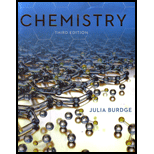
Interpretation:
The preparation of metal chlorides by various methods is to be stated.
Concept introduction:
Metal chlorides are the compounds that are formed by a metal and chlorine. They can be ionic compounds, covalent compounds, or
Metal chlorides are formed by various methods:
A metal chloride can be prepared by a direct reaction of a metal and molecular chloride. This reaction is very exothermic and hence, impractical for use.
Metals react with acids to form salts and release hydrogen gas. The metals that are more reactive than acids replace hydrogen to form salts.
A neutralization reaction involves the reaction of an acid and a base to give salt and water.
The reaction between a metal carbonate andacid results in the formation of a corresponding salt, carbon dioxide, and water.
The reaction that involves the formation of an insoluble salt by the mixing of two soluble salts is known as a precipitation reaction.
Want to see the full answer?
Check out a sample textbook solution
Chapter 24 Solutions
Chemistry
- I'm having trouble with converting lewis diagrams into VSEPR diagrams. I currently have this example of C2BrCl3 which I want to turn into a lewis structure, but I'm not sure what steps I need to do in order to do so. I have the table written down, however, there's two central atoms so what would I do? There seems to be 4 electron domains on the carbon atom and no lone pairs so it would seem like this shape would be tetrahedral. Here's what I have now. Thanks!arrow_forwardWe discussed the solid phase resin using in peptide synthesis. Provide a mechanism, for its formation. DRAW THE MECHANISM.arrow_forwardPlease help. Every time I've asked an expert in the past, it's been wrong :(arrow_forward
- Please help everysingle time ive asked in the past, the solution has been wrongarrow_forwardPlease helparrow_forward(a) 21.8 Name the following compounds. & (b) Br (e) O₂N. (h) H (c) Br (d) NH2 ☑N Br H ہیں Ph (g) OMe бл .0-0.e 21.9 Draw a structural formula for each compound. (a) 2,3-Dinitrotoluene (c) Diphenylmethanol (e) p-Nitroaniline (b) 3-Propylanisole (d) m-Propylphenol (f) Pentabromobenzenearrow_forward
 Chemistry: The Molecular ScienceChemistryISBN:9781285199047Author:John W. Moore, Conrad L. StanitskiPublisher:Cengage Learning
Chemistry: The Molecular ScienceChemistryISBN:9781285199047Author:John W. Moore, Conrad L. StanitskiPublisher:Cengage Learning Chemistry for Engineering StudentsChemistryISBN:9781285199023Author:Lawrence S. Brown, Tom HolmePublisher:Cengage Learning
Chemistry for Engineering StudentsChemistryISBN:9781285199023Author:Lawrence S. Brown, Tom HolmePublisher:Cengage Learning

